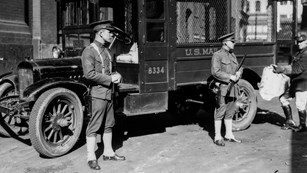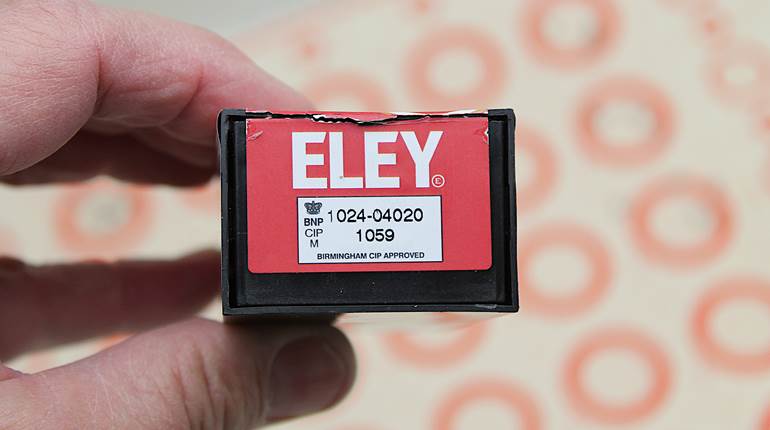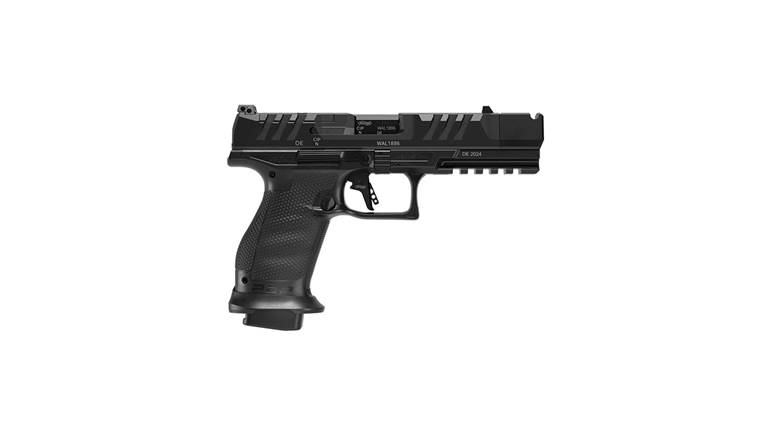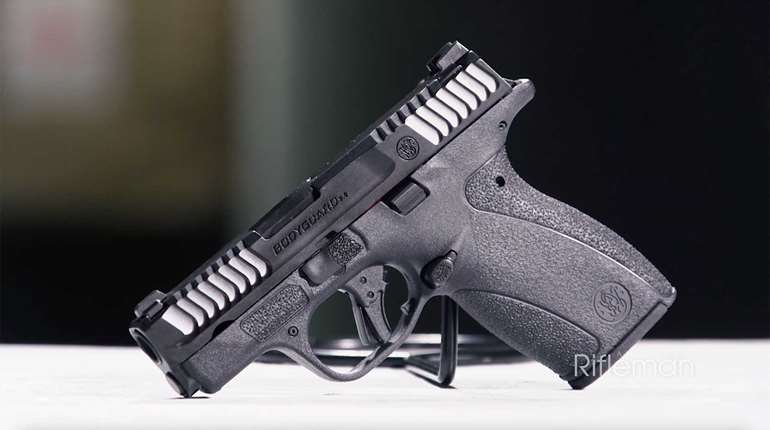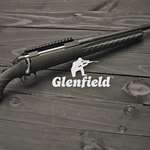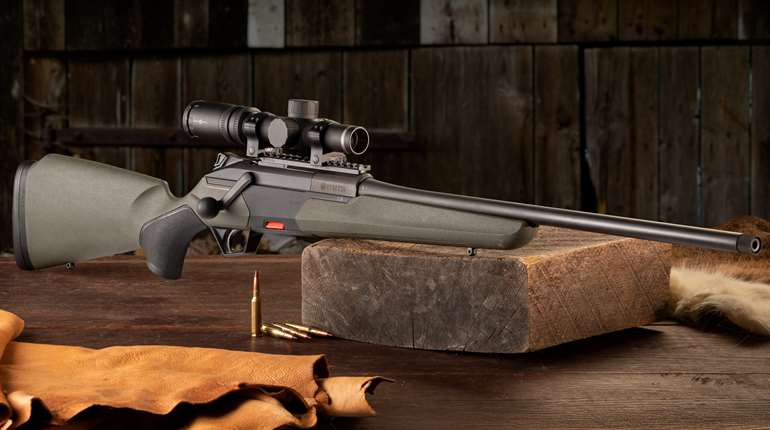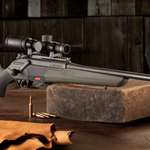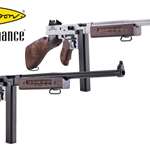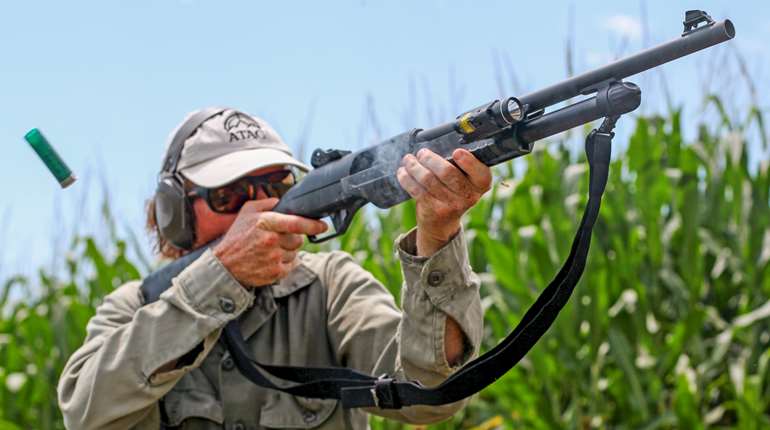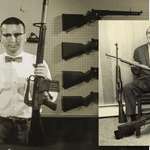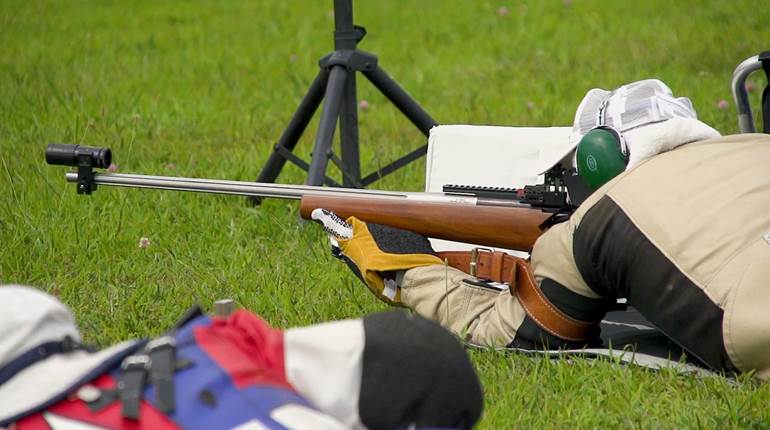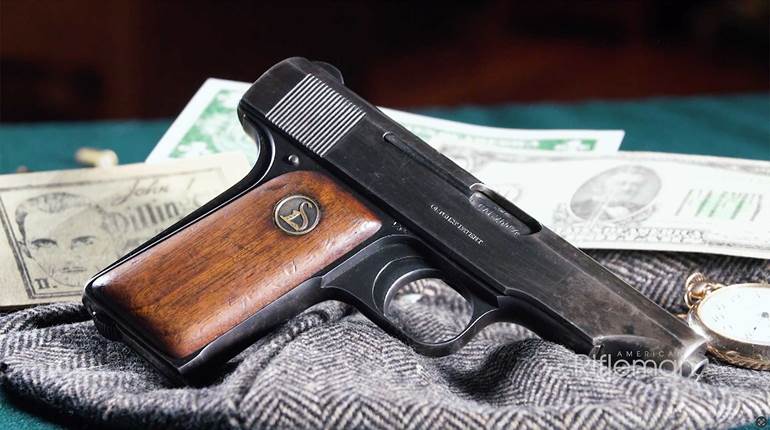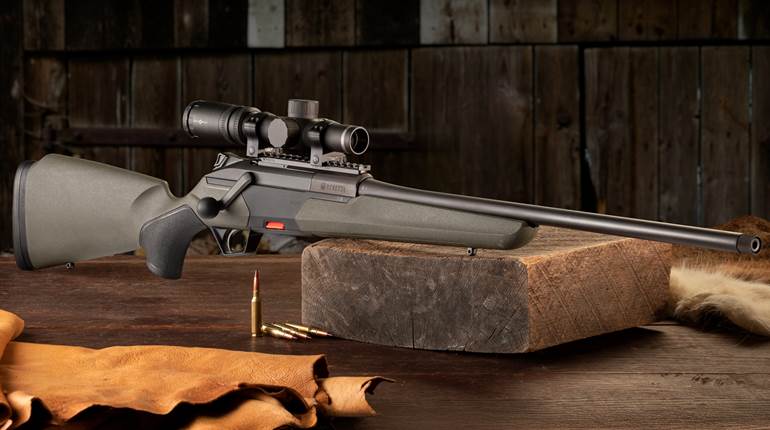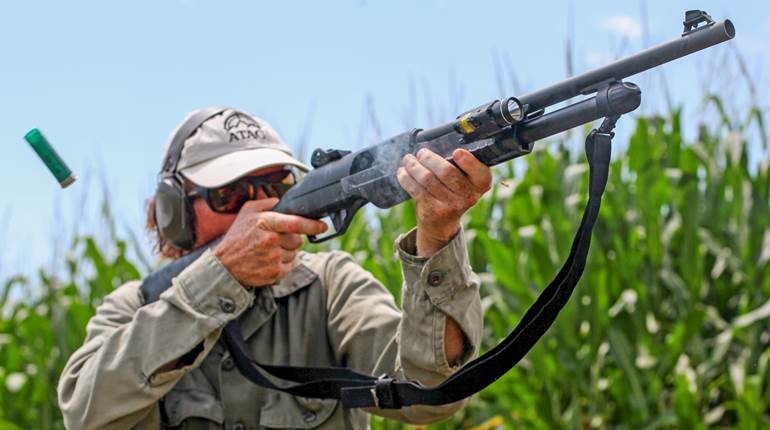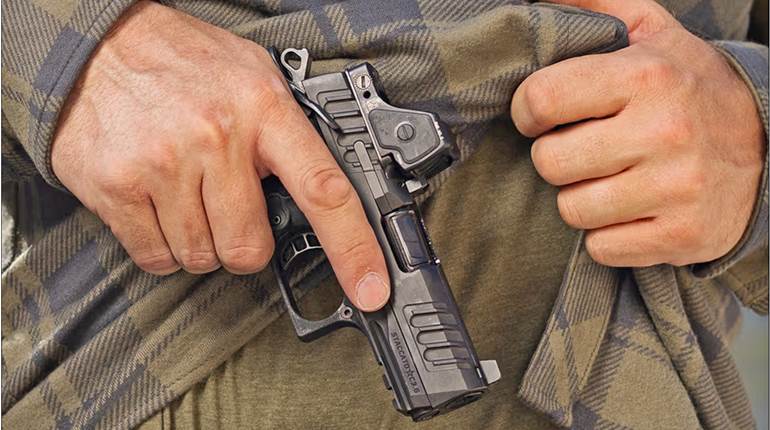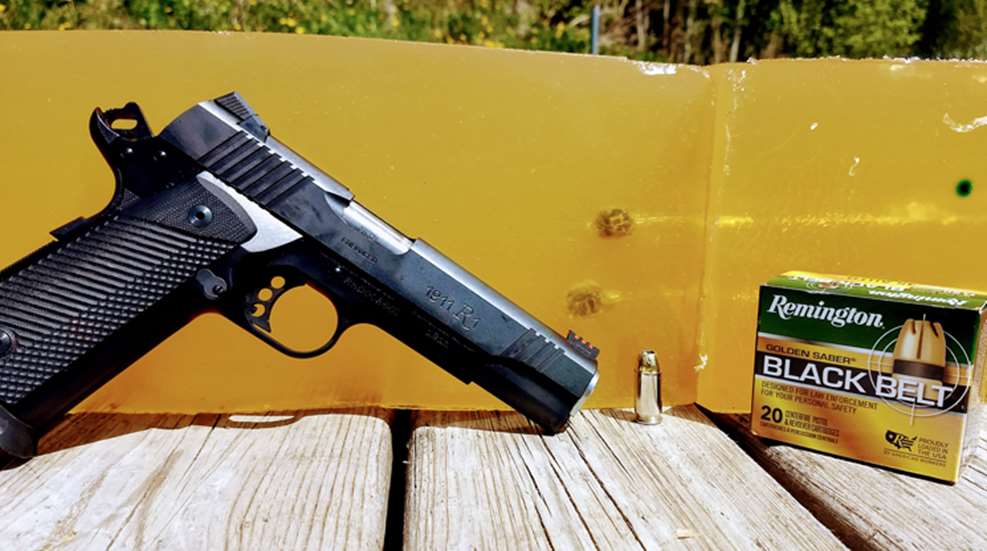
Self-defense handgun ammunition presents a testing and evaluation problem. It is, after all, made to stop human assailants, and you can’t go around “testing” out the ammo on people. So when Remington began shipping its Golden Saber Black Belt self-defense ammunition in 9 mm+P and .45 Auto, I lined up blocks of 10 percent ballistic gelatin so I could see how the new ammo fared—against gel, at least. 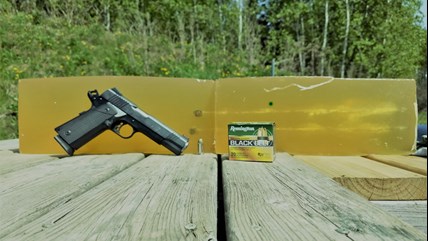
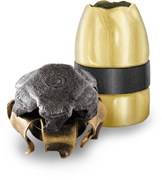
Using a Remington RI 1911, the Black Belt .45 Auto rounds penetrated an average of 17.25" of gel covered in four layers of clothing. Right: Golden Saber Black Belt unfired expanded bullet (Remington image)
The Black Belt bullets are constructed from an hour-glass shaped lead core with a brass jacket held in place by what Remington terms its “Mechani-Lokt” belts. A black Mechanic-Lokt belts secures jacket to core at the mid-section and the rear. The bullet also features a hollow point cavity with spiral nose cuts on the brass covering the outside of the cavity.
All which, Remington claims, prevents core and jacket from separating, creating high bullet-weight retention and deep penetration.
It sounded impressive. And while I didn’t try out Golden Saber Black Belt ammunition on hard surfaces like steel or vehicle windshields, it performed very well on gel and was quite accurate.
I received three boxes each of the new Golden Saber Black Belt in 9 mm+P, firing a 124-gr. bullet, and .45 Auto with a 230-gr. bullet. I took the ammo and a couple of pistols to my local shooting range, along with two gel blocks, to see what I could discover about this new ammunition.
The Federal Bureau of Investigation’s (FBI’s) Ballistic Test Protocol for handgun ammunition is a very involved process, one that really requires a good deal of time and money, plus a dedicated shooting facility. Yet, all the various Protocol tests the FBI does employ those 16" long blocks of ballistic gel. The gel is used because it is similar in texture and resistance to human flesh. Similar, though no one really claims gel blocks represent a one-to-one relationship to the effects of a particular ammunition on a human being.
According to numerous sources, including an American Rifleman article written when the FBI instituted its new Test Protocol (following the infamous Miami shoot-out of 1985), no matter what material a bullet may first pass through (heavy clothing, drywall, windshield glass, etc.), the FBI believes the bullet must be able to penetrate at least 12" of gel and no more than 18".
The 12" requirement reflects how deep a bullet may need to go to hit vital organs; up to 18" as a bad guy may take a bullet in the side, which means more distance to reach those same vitals. The FBI considers anything more than 18" of penetration a problem, as a bullet is then going far beyond the intended target and is at risk to strike innocent bystanders.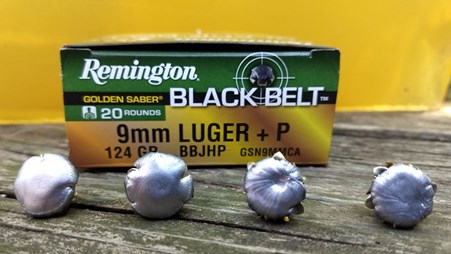
Black Belt 9 mm+P after get testing. The two on left were shot into pure gel; the two on the right into gel covered with heavy clothing.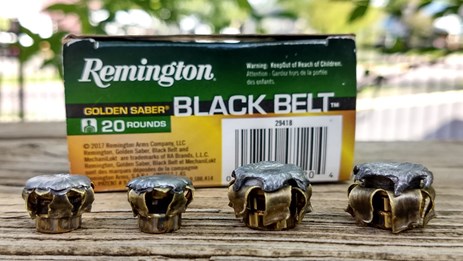
Black Belts fired into gel covered with heavy clothing. Left two, 9 mm+P; right two, .45 Auto
I don’t claim to have done the exact FBI tests, but here’s what I did:
First I shot bare ballistic gel with two rounds of each caliber to get a baseline measurement of penetration.
Then I covered the gel with four layers of cloth (T-shirt, cotton dress shirt, mid-weight cotton fleece, and denim) and shot the gel twice.
I shot from 10 feet, end of the muzzle to the front of the gel blocks, per the FBI Protocol.
The layers of cloth generally followed the FBI’s test on the “Heavy Clothing Barrier.” Few gun fights, after all, are fought against naked people. And layers of clothing can affect bullet performance.
Firearms used: .45 Auto Remington R1 Enhanced double-stack 1911; 9 mm Walther PPQ sub-compact.
Here’s what happened:
My first shot into gel with the 230-gr. .45 Auto went all the way through the 16" gel block. So I pushed block number two against the first block, and shot again. This bullet penetrated 15.1" of bare gel. When I covered the front of the gel block with the four layers of clothing, the two bullets then averaged 17.25"s of penetration.
.45 Auto Expansion: My single gel-only bullet expanded to .735", while the two bullets fired into the cloth-covered gel averaged .725" of expansion.
The two 124-gr. 9 mm+P Black Belts punched through an average of 13.5" of bare gel, while the second pair of bullets penetrated 17.65" of the gel covered in cloth.
9 mm+P Expansion: In the bare gel, the 9 mm bullets expanded to an average of .590", and in the cloth-covered gel averaged .614".
I was a little surprised the expansion was not larger. Other self-defense rounds I’ve tested came a lot closer to a 2X expansion.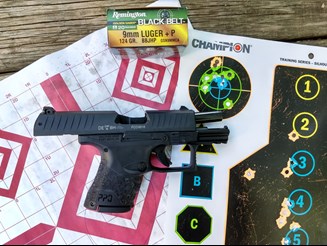
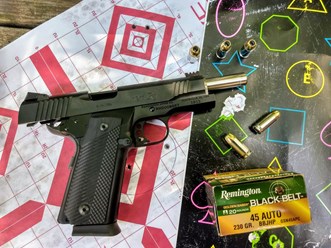
At seven yards standing and firing offhand, both the Black Belt 9 mm+P and .45 Auto were very accurate.
However, the front sections of the Golden Saber bullets peel back. At some point in the bullet’s penetration, those petals are at full extension, creating a larger wound channel, and are then pushed backward and around the rear of the bullet. (see “Golden Saber Black Belt expanding bullet CG video”)
This means that the actual expansion process for the Black Belt bullets is as follows: none as it initially strikes the gel; some as it moves forward; much more as the bullet travels deeper and petals come out fully; and then ends with the expansion I measured as the petals curl around the shank of the bullets.
Does this make Black Belt bullets superior or inferior to bullets with a slightly larger end expansion? To determine either of these, you’d have to test several varieties of self-defense ammunition, find out when the full expansion occurs, how long it lasts and the corresponding impact on the wound channel—and then compare that to the Back Belt’s variable expansion and wound channel track. That would take a high-tech FBI Ballistics Lab.
Weight retention was amazing. I weighed the bullet with a GemPro 250 Precision digital scale from Brownells. The two 9 mm Black Belts fired into gel-only weighed 123.98 grains and 124.00 grains. The two 9 mms fired into the cloth-covered gel weighed in at 122.70 grains and 123.20 grains. Remember, the original bullet weight was 124.00 grains.
The single 230-gr. .45 ACP fired into gel only came out weighing 229.6 grains, while the two bullets fired into the cloth-cover gel registered 229.22-grains and 229.74-grains.
Of course, if the bullets had first passed through steel, glass, or bone, they no doubt would’ve shed some weight.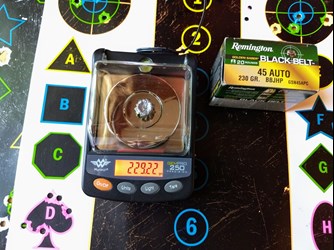
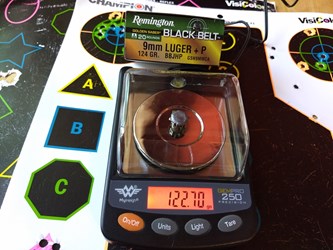
Both calibers displayed impressive weight retention. Both bullets on the scale were fired into clothing-covered gel.
I also chronographed the Remington ammunition, 10 rounds of each caliber with my PACT Professional Chronograph from Brownells. The chronograph sat five feet from the muzzle of each barrel. The .45 Auto averaged 780.1 feet per second (fps), with a standard deviation of 16.2 fps. The 9 mm+P averaged 969.4 fps, with a standard deviation of 23.2 fps.
Accuracy was quite good in what was, admittedly, relatively little testing. Shooting at seven yards, standing and using both hands, I had no problem pegging five-shot groups at 1.00- to 1.25" with both calibers, as long as I did my part. My best five-shot group with the .45 Auato Black Belt was .813". I placed eight rounds of the 9 mm into a 1.41" group. Round Number 9 expanded the overall group to 2.0", and I have no clue where Round Number 10 went.
Why seven yards? The FBI uses the 10 foot distance between muzzle and gel block because most law enforcement gun fights occur at very close ranges. Like three yards and less. Seven yards, I figure, gives a good indication of mid-range gun fight distances, and whatever accuracy is possible at seven yards, I’d assume would be even better at less than half the distance.
All in all, I was quite impressed with the penetration and expansion of the Black Belt ammunition. When I saw how accurate it was in the R1, I tried the .45 Auto in my EDC, a Smith & Wesson 45 Shield M&P, and drilled nearly everything I aimed at from seven to 10 yards, at which point I switched my EDC ammunition to the Black Belt.
My next test? Wild hogs in Texas. I figure if a Golden Saber Black Belt in .45 Auto can drive into the tough skin, hard muscle and solid bones of a 150-lb. hog and kill said hog at 20 yards or less? It can and will put the major hurt on any bad guy with bad-guy intentions.
To be continued …










